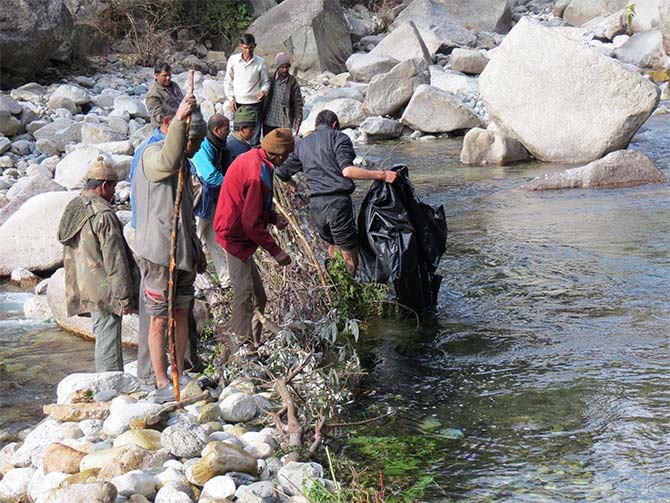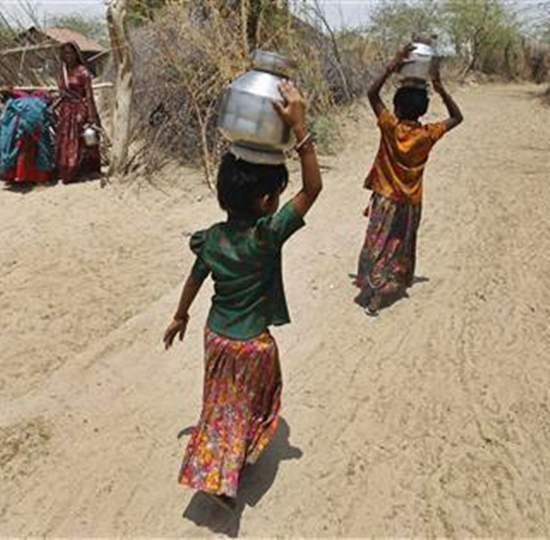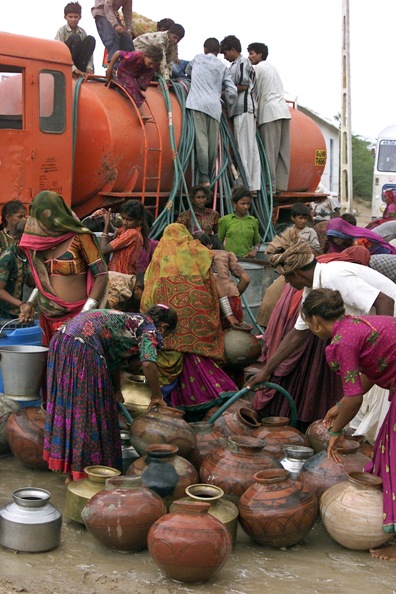 | « Back to article | Print this article |
Fear of drought, power deficit woes heightens
The sluggish southwest monsoon, which yielded one of the driest Junes in a century this year, appears disappointing this month as well.
The absence of a revival that was expected from July 6 has heightened the possibility of a drought in 10 per cent of the districts where kharif crops are sown and increased the fear of a power deficit problem spreading from the South to other parts of the country.
According to India Meteorological Department (IMD) data, monsoon till Friday was 43 per cent short of the normal level - the worst since 2009, when India had suffered its severest drought in 30 years. Until the end of last month, too, the monsoon rainfall was 43 per cent less than normal.
Until Friday, rainfall in the northwestern parts of the country was 52 per cent less than normal, while it was 61 per cent below that level in central India and 35 per cent less in the southern areas.
IMD, however, is hopeful the monsoon could gather momentum from Tuesday in North India, parts of which received some rainfall on Sunday as well. But the weather department warned the monsoon might remain weak over western parts of India for the next 15 days.
Please click NEXT to read more…
Please click here for the Complete Coverage of Budget 2014 -15
Fear of drought, power deficit woes heightens
This forecast has led to the fear of a drought in at least 40 of the 400-odd districts in the country where sowing of kharif crops takes place.
Department of agriculture officials said the situation in Gujarat, Maharashtra and Rajasthan looked grim so far. Maharashtra's Vidarbha and Marathwada areas, Gujarat's Kutch and Surat, and the entire Rajasthan were staring at the possibility of a drought. If it indeed happens, production of pulses, oil seeds, coarse cereals and some vegetables could be affected.
This might raise the prices of these products, compounding the problem of inflation seen due to high prices of some vegetables like onions, potatoes and tomatoes.
As of Friday, kharif sowing had taken place over 25.66 million hectares, about half the area covered during the same period last year, data from the agriculture department showed. More importantly, this is 35 per cent less than normal area - the average of area on which sowing took place in the past five years.
There could be a more severe crisis if power disruptions - currently confined to South India, mainly due to a weak monsoon bringing down water levels in the reservoirs there - spread to other parts of the country.
Please click NEXT to read more…
Please click here for the Complete Coverage of Budget 2014 -15
Fear of drought, power deficit woes heightens
 Power problems are feared to hit central, western and northern parts of the country over the next 10-15 days. In fact, water levels in 85 major reservoirs across India have receded.
Power problems are feared to hit central, western and northern parts of the country over the next 10-15 days. In fact, water levels in 85 major reservoirs across India have receded.
The electricity deficit has widened in South India and spot power prices have zoomed over the past few weeks, fuelling concerns of a pan-Indian effect of the worrisome trend.
The southern region recorded a peak power deficit of seven per cent in June, compared with 1.7 per cent in West, two per cent in East and three per cent in North. Also, this month so far, power prices in the spot market of the South have stayed between Rs 7 and as high as Rs 19 per unit. By comparison, the highest price recorded in other regions has been Rs 5 a unit.
The power shortage in the South has been worsened by the lack of a transmission corridor to import electricity from other regions. The state transmission utility's power grid is yet to commission the second half of the 765-kiloVolt line between Sholapur in Maharashtra and Raichur in Karnataka, which is crucial to importing 2,100 Mw of power.
Of the 30 water reservoirs in southern India, water storage in 27 was less than 40 per cent of their capacity as on July 10. Storage in Andhra Pradesh's reservoirs was 67 per cent below the level the Central Water Commission considers normal. By that standard, storage in Tamil Nadu's reservoirs was 64 per cent below normal, Karnataka's 59 per cent less and Kerala's 47 per cent below normal.
In a record of sorts, Andhra Pradesh's Srisalam dam, with a mega capacity to store 8.3 billion cubic metres (bcm), has been dried empty by the extended rainless spell. At present, this dam has zero per cent storage, compared with 11 per cent last year and an average of 24 per cent over the past decade.
Please click NEXT to read more...
Please click here for the Complete Coverage of Budget 2014 -15
Fear of drought, power deficit woes heightens
 Similarly, Karnataka's Ghataprabha dam was left with a mere one per cent of its storage capacity, against last year's 23 per cent; Renuka dam had two per cent storage, compared with last year's 12 per cent, and Tamil Nadu's Vaigai dam had four per cent storage, against last year's 26 per cent.
Similarly, Karnataka's Ghataprabha dam was left with a mere one per cent of its storage capacity, against last year's 23 per cent; Renuka dam had two per cent storage, compared with last year's 12 per cent, and Tamil Nadu's Vaigai dam had four per cent storage, against last year's 26 per cent.
Central Water Commission (CWC) data also showed the situation in other parts of the country, too, was far from comfortable.
In North India, for example, water in major reservoirs was at 43 per cent of capacity as of July 10, compared with 53 per cent during the same period last year.
News agency PTI, meanwhile, reported on Sunday that in the wake of a sudden rise in demand for power due to hot weather conditions, the power distribution corporations in Haryana supplied an all-time record 190.10 million units of power in the state on Saturday and the transmission and distribution system took highest peaking load of 8,612 Mw. These figures for the corresponding day of last year were 166.01 million units, with 7,755 Mw peaking load on the system.
In western parts, comprising Gujarat and Maharashtra, water levels in reservoirs were 21 per cent of full capacity, compared with 28 per cent in the same period last year.
Similarly, water levels in the reservoirs of central India were at 30 per cent of total capacity, against 38 per cent in the same period last year.
So far, the impact of reservoirs' receding water levels on power has been more pronounced in South India, as this region had received very little rainfall during the winters as well.
Please click here for the Complete Coverage of Budget 2014 -15




